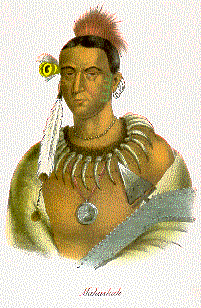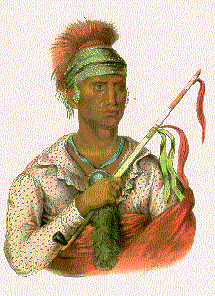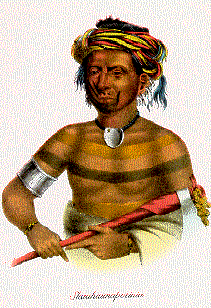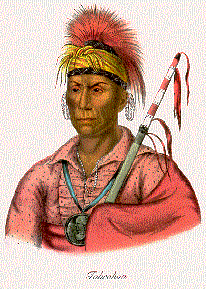Ioway Paintings from the McKenney Archives
Perhaps these are the most well-known pictures of Iowas.
They are actually lithographs (a type of print) based on oil
paintings by the noted painter of the 1820s-1830s, Charles Bird King. King was
not a frontier painter, but a studio portrait painter in Washington DC. Thomas
McKenney, Superintendent of Indian Affairs under Presidents Madison, Monroe,
Adams, and Jackson, commissioned the original paintings from King.
McKenney would take the Indians to King's studio, when the
chiefs came to Washington to make treaties or complain about the treatment of
their people. After his dismissal by Jackson in 1830, McKenney launched an
ambitious project, which was to make a folio (collection) of lithograph prints
from the original paintings. The three volumes were entitled "The Indian Tribes
of North America with Biographical Sketches and Anecdotes of the Principal
Chiefs" and first appeared together in 1837. McKenney hired a writer, James
Hall, to write the text based on notes supplied by McKenney. Even 130 years ago,
the costs to publish them was staggering, estimated in the 1830s at $100,000.
Today the set is found only in rare book collections. Luckily the prints were
published, as the original portraits were destroyed in 1865 when the
Smithsonian, where they were hanging, burned down.
James D. Horan, a scholar of western history, wrote the book
"The McKenney-Hall Portrait Gallery of American Indians" with many of the color
lithographs reproduced from original sets, excerpts from Hall's writings, and
some original research Horan made on the portraits and the life of McKenney.
Unfortunately, this book, published in 1972, is currently out of print. Some of
the following images, selected and reviewed here only for educational fair-use
purposes, are from Horan's book, which will again be in print soon I
hope.

"Mahaskah, or White Cloud."
Translation:
makh(uwe) (cloud) + ska (white). White Cloud I. Lithograph after 1824 Charles
Bird King painting. His wife was Flying Pigeon, and his son was White Cloud II,
or Francis "Frank" White Cloud.

"Rantchewaime, or Flying Pigeon."
Lithograph
after 1824 Charles Bird King painting.
Translation: ruche (pigeon) + wayin (flying) + mi (female). Wife of White
Cloud I, mother of White Cloud II.

"Mahaska the Younger."
Lithograph after 1837
Charles Bird King painting.

"Moanahonga, or Great Walker."
Lithograph after
1824 Charles Bird King painting.
Translation: manyi (to walk) + hongeh (great)

"Neomonni, or the Cloud out of Which the Rain
Comes."
Lithograph after 1837 Charles Bird King painting.
Translation: nyiyu (rain) + manyi (goes along; to walk)

"Notchimine, or No Heart."
Lithograph after
1837 Charles Bird King painting.
Translation: nahsje (heart) + nyinge (none)

"Shauhaunapotinia, or the Man Who Killed Three
Sioux."
Lithograph after 1836 Charles Bird King painting.
Translation: shahan (Sioux) + napo + danyi (three) + a

"Tahrohon."
Lithograph after 1837 Charles Bird
King painting.
Translation: ta (deer; deer meat) + rohan (much; a lot)

"Watchemonne, or the Orator."
Lithograph after
1838 Charles Bird King painting.
Translation: wach'e (war honor title: "successful partisan"- not literal
translation) + manyi (walks; goes along)
Return to top
Return to People page
Return to History main page
|